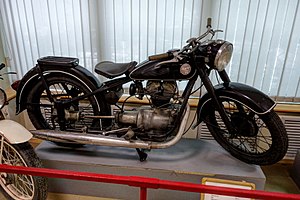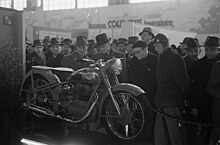AWO 425
| AWO | |
|---|---|
 AWO 425 T |
|
| 425 T / 425 S. | |
| Manufacturer | VEB vehicle and equipment factory Simson Suhl |
| Motor data | |
| Four-stroke - gasoline engine | |
|
|
| drive | Cardan |
| Wheelbase (mm) | 1361-1375 |
| Empty weight (kg) | 140-156 |
| Previous model | BMW R 23 |
The AWO 425 was a motorcycle with a four-stroke engine built in the GDR in two model versions. The motorcycle was in the Awtowelo - or later IFA OPERATION Simson in the Thuringian Suhl made.
history
After the Second World War , several factories of the former arms and vehicle production in the Soviet-occupied part of Germany were converted into a SAG (Soviet stock corporation) with the name " Awtowelo ". These had the task of fulfilling reparations payments. Only after the self-administration was approved, the AWO manufacturer traded as VEB Fahrzeug- und Gerätewerk "Simson" Suhl from 1957 .
In 1948 the Soviet head office placed the order for the development of a motorcycle with a single-cylinder four-stroke engine, 12 HP , about 100 km / h top speed and about 3 l / 100 km fuel consumption. In July 1949 the first functional model and on May 1, 1950 a first pilot series of 25 motorcycles was completed. Series production started in September 1950. The main designers of the AWO 425 were Ewald Dähn , Helmut Pitz and Michael Heise. The "4" in the model name stands for the four-stroke engine , the "25" for 250 cm³ displacement . Due to the engine power and the stability of the frame, the motorcycles are suitable for sidecars . In 1952 the company was transferred to the VEB "Fahrzeug- und Gerätewerk Simson". Numbers of up to 20,000 copies per year were produced and some model maintenance measures, such as oil-damped front fork, stronger cardan drive, etc. followed. Since the beginning of 1955, all frames have generally been pre-equipped with the appropriate holders.
After the AWO 425 T, which was technically based on the BMW R 23 , the AWO 425 S was a completely new sporty model. In 1955 the AWO 425 S made its debut, which experienced an increase in output of 2 HP by redesigning the cylinder head and thereby increasing the engine output slightly. After a pre-series launched in 1956 and exhibited at the Leipzig Trade Fair in the same year , the AWO 425 S began series production in 1957. In 1958 some improvements were made to the 425 S: The mounting of the rocker arms in the cylinder head was improved so that the valve noise was reduced. Some changes were made to the chassis in detail. In addition, the exhaust has been moved higher and closer to the machine. The AWO T received a modified exhaust system to reduce noise. A suitable, modern sidecar was also available from Stoye from 1958 . In 1958 the name was changed to Simson 425 and 425 S and now, instead of the full-length bench, spring-loaded single seats were also available. In 1960, the 425 S, now known as Simson Sport, was further improved; the chassis was optimized using a rear swing arm with hydraulically damped struts, 18-inch wheels and large aluminum full brake hubs.
Road racing machines were temporarily built at the factory for a factory team and for private racing drivers in small series. The AWO engines were constantly improved through races in the GDR championship series. Double-cam engines with vertical shaft and later encapsulated chain drive increased the performance of the motorcycle significantly and in 1953-55 the AWO machines won the GDR championships in the 250cc class. After giving up participation in road racing, an enduro version was built for competition purposes , in some cases with a displacement up to 350 cm³. In addition, there were also private conversions to three-wheel load carriers with tipping devices.
A total of around 212,000 four-stroke motorcycles were manufactured in Suhl. In 1961 production had to be given up on instructions from higher-level departments, despite great demand, in favor of 50 cm³ small motorcycles and the MZ two-stroke engines. The start of series production of the Simson-Sport with a 350 cm³ engine and a new design was prevented. This decision by the State Planning Commission of the GDR caused great disappointment in Suhl. Another heavy sidecar machine developed by EMW was to be built in Suhl as the AWO 700 . Seven to ten prototypes were made. There is still a complete team that was preserved in the GDR and today belongs to a collector in Jüchen. There was no series production of this "Boxer-AWO".
Even in the GDR era, the AWO achieved cult status - not least because of the obvious lack of modern four-stroke motorcycles. Far away from government plans, an AWO scene established itself, often supported by private car workshops that took care of the procurement of parts and the repair of the four-stroke engines. After the fall of the Wall, a vehicle museum was built in the former Simson factory in Suhl. Every year a meeting of AWO fans with their machines takes place in the former factory premises.
Properties and distribution
In the vernacular, the AWO were respectfully called "steam hammer" due to the sound of the engine. The AWO was very popular in the GDR alongside the outdated EMW R 35 as the only available four-stroke motorcycle. Due to the lack of four-stroke offers from other manufacturers on the GDR two-wheel market, the motorcycles were later converted individually. For example, the longer and better fork from the MZ was used. Large parts of the AWO inventory are lovingly cared for to this day. Today, the large number of AWO motorcycles and spare parts that are still available enables a good introduction to vintage motorcycles. A similar machine, which also had a similar history (and also achieved cult status), was the Polish SFM Junak , which, however, was not imported into the GDR.
technology
The AWO has a dual loop - tubular frame with hydraulically damped telescopic fork forward and Geradwegfederung (Tourenawo) and swinging suspension behind. The magneto ignition worked independently of the 6 volts - board power supply , the battery of a patch on the front tail shaft alternator is charging. The ignition switch is located in the lamp housing, which also houses control lamps for idling and light function.
From the beginning of 1954 an improved transmission with still four gears was installed. From 1955, the AWO 425 had three frame mounts for quick assembly of the Stoye Stoye SM sidecar (pointed ship without lockable trunk). The AWO Sport has four frame mounting points, so that the Stoye Elastik (pointed ship with oscillation suspension) or, with minor modifications , the Stoye Super-Elastik sidecar originally developed for the MZ (sprung, foldable, hydraulic sidecar brake parallel to the foot brake) can be installed. A cardan drive with a shorter reduction ratio and a modified speedometer drive were available as a conversion kit.
Magneto ignition sometimes caused difficulties due to magnet and coil damage. Many vehicles were retrofitted with battery ignition, but this had the disadvantage of being dependent on the battery charge. Frequent drivers therefore partially equipped their vehicle with both ignition systems, so that if the magneto ignition failed, the ignition cable could be switched to battery ignition.
AWO 425 - "Touring AWO"
| Power: | 9 kW (12 PS ) |
|---|---|
| Displacement: | 248 cc |
| Hub: | 68 mm |
| Drilling: | 68 mm |
| Landing gear: | Double loop frame with straight travel suspension |
| Power transmission: | Four-speed gearbox with cardan drive |
| Tank volume: | 12 liters |
| Fuel consumption: | 3.3 liters / 100 km |
| Electrical system: | DC - generator with 6 V / 45 W |
The model was called "AWO 425" until 1956, later called "Simson 425". Between 1950 and 1961, 127,000 AWO 425 (chassis from 000 001 to 127 865) were built.
AWO 425 SPORT - "Sports AWO"
| Power: | 10.3 kW (14 PS ) from 1961: 11.4 kW (15.5 PS) |
|---|---|
| Displacement: | 248 cc |
| Hub: | 68 mm |
| Drilling: | 68 mm |
| Landing gear: | Double loop frame with swing arm and spring legs |
| Power transmission: | Four-speed gearbox with cardan drive |
| Tank volume: | 16 liters |
| Fuel consumption: | 3.7 liters / 100 km |
| Electrical system: | DC - dynamo with 6 V / 60 W |
The completely redesigned chassis with rear swing arm suspension, together with the improved engine and full-hub brakes, ensured greater safety and driving comfort. While the first models had a sporty double seat bench, this was replaced from 1958 by comfortable but somewhat bulky single seat cushions with handles for the pillion passenger . About 85,000 machines in the chassis range 150,000 to 234,746 were produced.
The model was called "AWO 425 SPORT" until 1958, later called "Simson Sport". The AWO magneto ignition was also installed identically in the Polish SFM Junak . A small series was produced for escort vehicles with the 350 cm³ engine of the enduro version. This engine version was also available from retailers as a retrofit kit, but only in limited numbers.
literature
- Eduard Werner: East German motorcycle classics Simson 425 and Simson Sport. Uwe Welz Verlag, 1999, ISBN 3-933177-04-9 .
- The 250 cc - "AWO 425". In: Motor Vehicle Technology 7/1951, pp. 165–166.
- what's new? In: Motor vehicle technology 11/1952, p. 332 (technical improvements to AWO 425).
- 7000 km with the AWO team. In: Motor Vehicle Technology 7/1955, pp. 237–242 and 12/1959, pp. 488–491.
- Sport-AWO 425 S. In: Motor vehicle technology 6/1956, pp. 224–226.
- Repair manual for motorcycle SIMSON-SPORT (AWO) Edition 1959 VEB vehicle and equipment factory Simson, Suhl (Thür.) Fachbuchverlag Leipzig 1959.
Suggestions for improvement
- Installation of an oil damper in the AWO telescopic fork. In: Motor vehicle technology 1/1957, p. 33.
- Influence of the valve timing on the AWO 425 motorcycle engine . In: Motor Vehicle Technology 12/1960, pp. 476–482.
Web links
- awoforum.de forum with useful tips about the AWO 425
- Hille's AWO 425 page - lots of useful information about the AWO 425
- Website on the topic of restoration of AWO 425
- AWO 700 - photos and information
- awo story
- Ostmotorrad.de - Most extensive site on the topic of Simson, AWO circuit diagrams, old newspaper articles, reports, operating instructions, spare parts lists
- bayer-frank.de - Interesting facts about the Simson AWO 425 tours and sports
- graef-medien.de - 360 ° view of an AWO 425
Individual evidence
- ↑ Simson with new type designations. In: Motor vehicle technology 2/1957, p. 76.
- ^ A b c d e Eduard Werner: East German motorcycle classics Simson 425 and Simson Sport. Uwe Welz Verlag, 1999, ISBN 3-933177-04-9 .
- ^ Motor vehicles at the Leipzig spring fair in 1956. In: Motor vehicle technology 3/1956, pp. 84–85.
- ↑ Improvements to Simson motor vehicles. In: Motor vehicle technology 6/1958, p. 236
- ↑ state-owned motor vehicle at the Leipzig Spring Fair 1960. In: Automotive Engineering 3/1960, p 99
- ↑ Motor vehicle technology 4/1957, p. 157.
- ^ The new transmission of the AWO 425. In: Motor vehicle technology 1/1955, pp. 22–23.
- ↑ AWO with double ignition. In: Motor Vehicle Technology, Issue 9/1955, pp. 324-325.
- ↑ Simson-Sport with 15.5 hp . In: Motor Vehicle Technology 05/1961, pp. 198–199.



